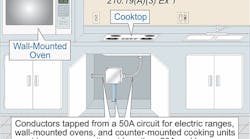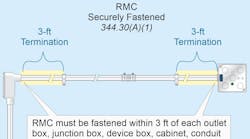Q. What are the tap conductor requirements to supply household ranges, wall-mounted ovens, and counter-mounted cooking units?
Find the Answer
A. Branch circuit conductors that supply household ranges, wall-mounted ovens, or counter-mounted cooking units must have an ampacity not less than the rating of the branch circuit — and not less than the maximum load to be served. For ranges of 8¾ kW or more, the minimum branch circuit ampere rating is 40A [210.19(A)(3)].
Exception No. 1: Conductors tapped from a 50A branch circuit for electric ranges, wall-mounted electric ovens, and counter-mounted electric cooking units must have an ampacity not less than 20A, and must have sufficient ampacity for the load to be served. The taps must not be longer than necessary for servicing the appliances.




